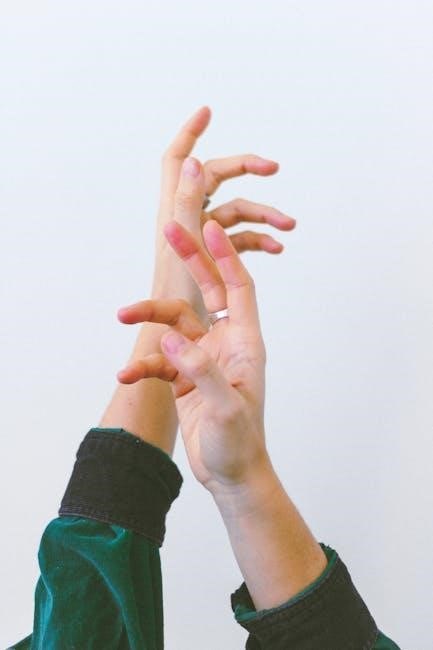Motorcraft Lacquer Touch-Up Paint is a high-quality, precise formula designed to repair minor scratches and chips on Ford, Lincoln, and Mercury vehicles, ensuring a seamless finish․
1․1 What is Motorcraft Lacquer Touch-Up Paint?
Motorcraft Lacquer Touch-Up Paint is a high-quality, precise formula designed to repair minor scratches and chips on Ford, Lincoln, and Mercury vehicles․ It is available in various forms, including pens, bottles with brushes, and spray cans, each tailored for different application needs․ The paint is formulated to match the original factory color, ensuring a seamless repair that blends flawlessly with the vehicle’s finish․ This makes it an ideal solution for maintaining your car’s appearance without the need for extensive repainting․ The product is trusted for its durability and exact color matching․
1․2 Importance of Using Genuine Motorcraft Products
Using genuine Motorcraft Lacquer Touch-Up Paint ensures a precise color match and superior durability․ It is specifically formulated for Ford, Lincoln, and Mercury vehicles, guaranteeing a professional finish․ Genuine products are designed to maintain your car’s original appearance and protect it from further damage․ They are tested to meet high standards, providing long-lasting results․ Avoiding generic alternatives prevents color mismatches and ensures compatibility with your vehicle’s factory paint․ Investing in Motorcraft products safeguards your car’s value and aesthetic appeal․

Understanding the Motorcraft Touch-Up Paint Kit
The Motorcraft Touch-Up Paint Kit is an all-in-one solution for minor paint repairs․ It includes a basecoat brush, basecoat pen, and topcoat applicator for precise, professional results․
2․1 Components of the Motorcraft Touch-Up Paint Kit
The Motorcraft Touch-Up Paint Kit includes a basecoat pen for precise application, a brush for larger areas, and a topcoat applicator for a glossy finish․ The kit also contains paint formulated to match your vehicle’s exact color, ensuring a seamless repair․ Additional tools like sandpaper and rubbing compound may be included for smoothing and blending the repaired area․ This comprehensive set provides everything needed to touch up minor scratches and chips effectively․
2․2 Differences Between Basecoat and Clear Coat
The basecoat is the colored layer that matches your vehicle’s paint, providing the desired hue and hiding power․ It is applied directly to the damaged area to cover scratches or chips․ The clear coat, on the other hand, is a transparent protective layer applied over the basecoat to seal the color, add gloss, and protect the paint from environmental factors․ Together, they ensure a durable and factory-like finish when applied correctly․
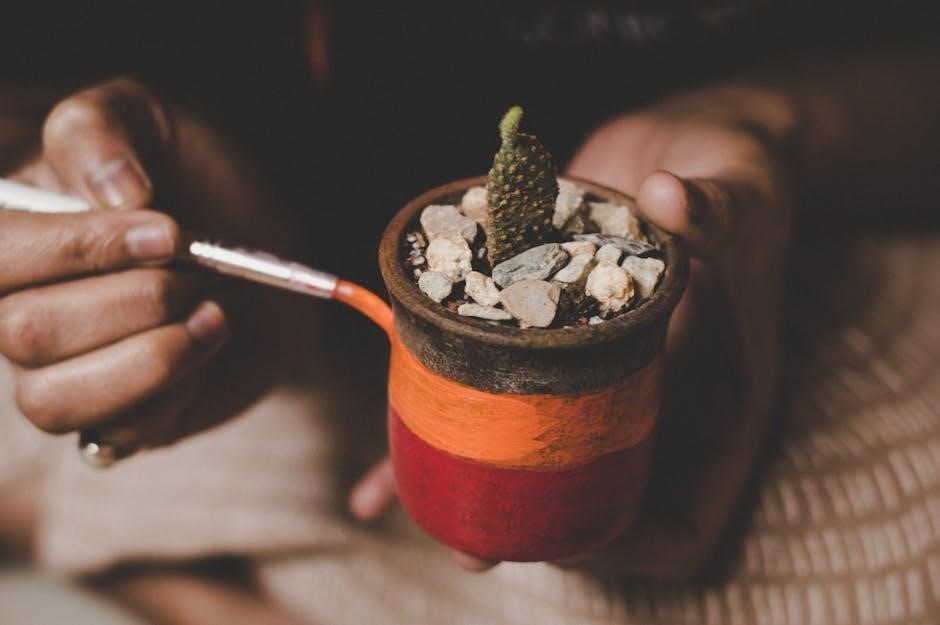
Preparing the Vehicle for Touch-Up Paint Application
Proper preparation ensures a smooth and durable finish․ Clean the area thoroughly, sand lightly to create a surface for paint adhesion, and remove all dust and debris․
3․1 Cleaning the Damaged Area
Cleaning the damaged area is essential for proper paint adhesion․ Use a general cleaner and a soft rag to remove dirt, grease, and contaminants․ Gently rub the surface to ensure no oils or residue remain․ Avoid using household cleaners, as they may damage the paint or clear coat․ Once clean, rinse the area with water and let it dry completely․ A clean surface ensures the touch-up paint adheres evenly and blends seamlessly with the surrounding finish․
3․2 Sanding the Scratched Surface
Lightly sand the scratched surface using 3000-grit sandpaper to feather the edges and smooth the area․ Sand in one direction to avoid creating swirl marks․ After sanding, use a clean, damp cloth to wipe away dust and debris․ This ensures the surface is even and ready for paint application․ Be cautious not to sand too aggressively, as this may enlarge the damaged area․ Proper sanding is crucial for a seamless blend with the surrounding paint․
3․3 Removing Dust and Debris
After sanding, use a clean, dry microfiber cloth to gently wipe away all dust and debris from the scratched surface․ For finer particles, lightly dampen the cloth with water or use a tack cloth․ Avoid using household cleaners, as they may leave residues․ Ensure the area is completely dry and free of contaminants before proceeding․ A clean surface is essential for proper paint adhesion and a smooth finish․ Inspect the area under good lighting to confirm no dust remains․
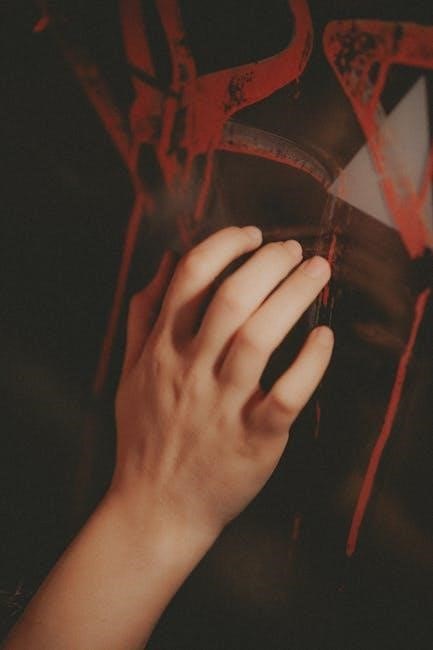
Applying the Basecoat
Use the Motorcraft Touch-Up Paint Pen to apply the basecoat directly to the scratched area, following the pen’s instructions for proper application technique and coverage․
4․1 How to Open the Touch-Up Paint Pen
To open the Motorcraft Touch-Up Paint Pen, rotate the white cover counterclockwise to access the basecoat brush․ Gently dab the brush on the paint surface to activate the paint flow․ For precise application, use the pen’s built-in brush to target small scratches or chips․ If using a separate brush, dip it lightly into the paint and wipe off excess on the rim of the bottle․ This ensures smooth, even coverage for minor touch-ups․
4․2 Applying the Basecoat: Step-by-Step Instructions
Dip the brush into the basecoat paint, wiping off excess on the bottle’s rim․ Gently dab the brush onto the scratched area, starting from the center and feathering outward․ Avoid overfilling, as this may cause unevenness․ Apply thin, even layers, allowing each coat to dry before adding more․ For small chips, use light, controlled strokes to blend the basecoat with the surrounding paint․ Repeat as needed until the area is evenly covered, ensuring a smooth base for the clear coat application․
4․3 Allowing the Basecoat to Dry
After applying the basecoat, allow it to dry completely as per manufacturer instructions, typically 15-30 minutes, depending on environmental conditions․ Avoid exposing the vehicle to direct sunlight or moisture during this time․ Do not attempt to speed up the drying process with heat, as it may cause unevenness or damage to the paint․ Once dry, inspect the area to ensure proper coverage before proceeding with the clear coat application․ Patience is key to achieving a smooth, professional finish․
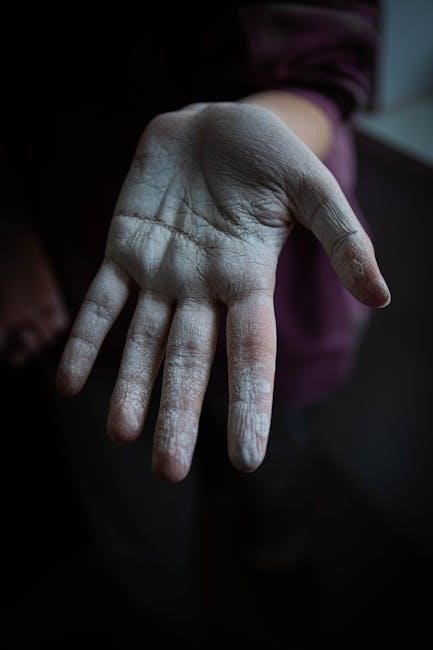
Applying the Clear Coat
Apply the clear coat in thin, even layers after the basecoat has fully dried, typically 30 minutes․ This step adds gloss and protects the basecoat from wear․
5․1 When to Apply the Clear Coat
Apply the clear coat after the basecoat has fully dried, typically 30 minutes to an hour․ Ensure the basecoat is dry to the touch without any tackiness․ For optimal results, wait at least 24 hours before applying the clear coat for a hard cure․ Avoid applying in direct sunlight or high humidity․ Use thin, even layers to prevent drips․ Allow each layer to dry slightly before applying the next․ This ensures a smooth, glossy finish that protects the basecoat and blends seamlessly with the vehicle’s paint․
5․2 Techniques for a Smooth Clear Coat Finish
For a smooth clear coat finish, apply thin, even layers using light, steady strokes․ Avoid overloading the brush to prevent drips․ Feather the edges to blend seamlessly with the surrounding paint․ Work in a controlled environment to minimize dust and debris․ Allow each layer to dry completely before applying the next․ Use a clean, lint-free cloth to wipe away excess paint․ Proper technique ensures a professional-looking finish that protects and enhances the basecoat’s appearance․
5․3 Drying Time for the Clear Coat
The clear coat typically dries to the touch within 20-30 minutes under normal conditions․ However, full curing may take several hours, depending on temperature and humidity․ For optimal results, allow the clear coat to dry completely before exposing the vehicle to moisture or direct sunlight․ In high humidity, drying time may increase․ Ensure the clear coat is fully cured before waxing or applying additional protective products to maintain its protective and glossy finish․
Additional Tips for a Professional Finish
Use light, even strokes for blending, and avoid over-applying paint․ Work in small areas to maintain precision and achieve a smooth, factory-like finish․
6․1 Using Rubbing Compound for a Seamless Blend
Apply a small amount of rubbing compound to a clean, soft cloth․ Gently buff the touched-up area using circular motions, feathering the edges for a seamless blend with the surrounding paint․ Work slowly, applying light pressure to avoid creating scratches․ This step ensures the repair blends naturally, leaving a professional-looking finish․ For best results, use a compound specifically designed for automotive paint and follow the manufacturer’s instructions carefully․
6․2 Avoiding Common Mistakes During Application
To achieve a professional finish, avoid applying too much paint at once, as this can lead to uneven results․ Ensure the surface is clean and dry before application, as dirt or moisture can compromise adhesion․ Avoid touching the repaired area with bare hands, as oils from skin can damage the paint․ Let each coat dry completely before applying additional layers․ Applying paint in direct sunlight or extreme temperatures can also lead to poor results․ Follow instructions carefully to prevent peeling or cracking․
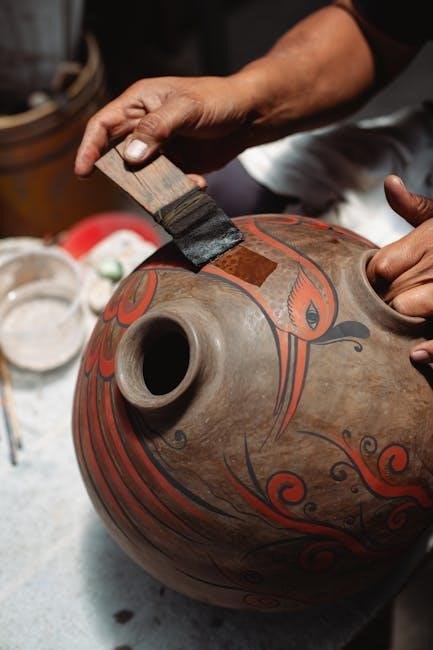
Curing the Paint
Allow the paint to cure completely for optimal durability and finish․ Most Motorcraft touch-up paints require 24 hours to fully cure, ensuring a hard, long-lasting finish․
7․1 Understanding the Curing Process
The curing process involves the paint hardening and bonding with the vehicle’s surface․ Motorcraft Lacquer Touch-Up Paint typically cures through evaporation of solvents and chemical reactions․ Ambient temperature and humidity significantly impact curing speed—ideally, it should occur in a warm, dry environment․ Avoid exposing the vehicle to water or moisture during this time․ Full cure can take up to 24 hours, depending on conditions, ensuring a durable and glossy finish․
7․2 How Long to Wait Before Using the Vehicle
After applying Motorcraft Lacquer Touch-Up Paint, it’s essential to allow the paint to fully cure before using the vehicle․ The paint typically requires 24 hours to completely harden and bond with the surface․ Light use may be possible after 12 hours, but avoiding exposure to water, moisture, or extreme temperatures during this period is crucial․ For optimal durability, wait at least 24 hours before washing or waxing the vehicle․ This ensures a strong, long-lasting finish․
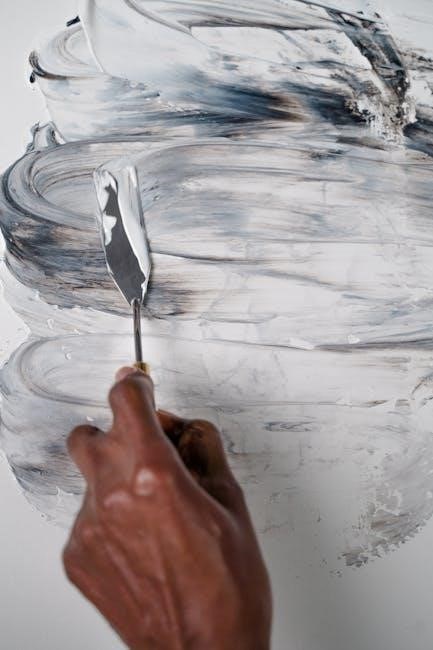
Touch-Up Paint Application for Different Surfaces
Motorcraft Lacquer Touch-Up Paint is suitable for various surfaces, including metal, plastic, and fiberglass․ Techniques may vary depending on the material to ensure proper adhesion and durability․
8․1 Applying Touch-Up Paint to Metal Surfaces
For metal surfaces, ensure the area is clean and free of rust․ Lightly sand the surface to create a smooth base․ Apply thin coats of Motorcraft Lacquer Touch-Up Paint using a small brush, allowing each layer to dry completely․ This method ensures proper adhesion and a durable finish․ Always use the correct color code for your vehicle to maintain a consistent appearance․ Avoid applying paint in direct sunlight or high humidity for optimal results․
8․2 Applying Touch-Up Paint to Plastic or Fiberglass
When applying Motorcraft Lacquer Touch-Up Paint to plastic or fiberglass, ensure the surface is clean and dry․ Lightly sand the area to create a rough texture for better adhesion․ Apply thin, even coats using a small brush, allowing each coat to dry completely․ Avoid heavy layers to prevent cracking․ For optimal results, use a primer specifically designed for plastic or fiberglass if necessary․ This ensures a durable and long-lasting finish that blends seamlessly with the surrounding material․
Troubleshooting Common Issues
Common issues with Motorcraft Lacquer Touch-Up Paint include uneven application, excess paint, or inadequate adhesion․ Lightly sand uneven areas and reapply thin coats․ For excess paint, gently wipe with a clean cloth․ Ensure the surface is clean and dry before reapplication․ If adhesion is poor, check for proper preparation and primer use․ Consult the product instructions or a professional if issues persist․
9․1 Dealing with Uneven Paint Application
Uneven paint application can occur due to improper technique or surface preparation․ Lightly sand the affected area using 3000-grit sandpaper to smooth it out․ Wipe away dust with a clean, dry cloth․ Apply thin, even layers of Motorcraft Lacquer Touch-Up Paint, allowing each coat to dry completely before reapplying․ Avoid overloading the brush or pen, as this can lead to drips․ For minor imperfections, use a small, soft-bristled brush to feather the edges for a seamless blend․ If issues persist, consider using rubbing compound to polish the area for a professional finish․
9․2 Fixing Excess Paint or Drips
If excess paint or drips occur, allow the paint to dry completely before addressing the issue․ Use 3000-grit sandpaper to gently sand the area, feathering the edges to blend with the surrounding paint․ Wipe away dust with a clean, dry cloth․ For minor drips, dab the area with a small, soft-bristled brush to spread the excess evenly․ Avoid over-sanding, as this may create new imperfections․ If necessary, apply additional thin coats of Motorcraft Lacquer Touch-Up Paint, ensuring smooth, even strokes with the pen or brush․ Patience is key to achieving a professional finish․
Maintenance After Touch-Up Paint Application
Regularly wash the vehicle with mild soap and water to maintain the paint’s integrity․ Avoid direct sunlight and high temperatures to prevent damage․ Use a soft cloth to wipe away contaminants and apply a high-quality wax periodically to protect the finish․ Avoid harsh chemicals and abrasive materials that could strip wax or damage the paint․ Keep the touched-up area clean to ensure durability and a professional appearance․
10․1 Washing and Waxing the Vehicle
After applying Motorcraft Lacquer Touch-Up Paint, maintain the vehicle’s appearance by washing it with mild soap and water․ Avoid using harsh chemicals or abrasive materials that could damage the paint․ Use a soft, clean cloth to gently wipe away contaminants, ensuring the touched-up area remains clean․ For added protection, apply a high-quality car wax periodically to create a barrier against environmental elements․ Regular waxing helps preserve the paint’s shine and durability, ensuring the touch-up paint blends seamlessly with the surrounding finish․
10․2 Protecting the Touched-Up Area
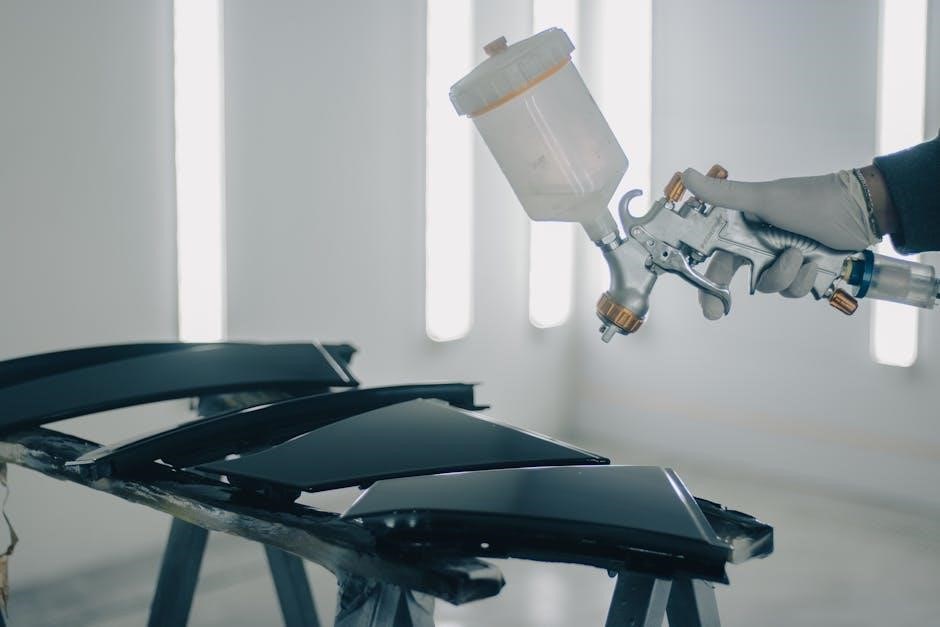
To protect the touched-up area, avoid exposing it to water or direct sunlight for at least 24 hours after painting․ Use a protective wax or sealant to shield the paint from environmental elements․ Avoid using harsh chemicals or abrasive materials that could damage the finish․ Regularly inspect the area for signs of wear or peeling and address them promptly․ Parking in shaded areas can also help prevent UV damage, ensuring the touch-up paint remains vibrant and durable over time․
Frequently Asked Questions
Common questions include application best practices, paint matching, and curing times․ Users often ask about suitable surfaces, drying durations, and preventing uneven finishes for optimal results․
11․1 Can I Apply Touch-Up Paint in Direct Sunlight?
Applying Motorcraft Lacquer Touch-Up Paint in direct sunlight is not recommended, as it can cause the paint to dry too quickly, potentially leading to uneven results or bubbles․ Ideal conditions are in a shaded area or a controlled environment with stable temperatures and humidity․ Direct sunlight may also cause the paint to cure faster than intended, which can prevent it from adhering properly or blending smoothly with the surrounding finish․ For best results, follow the product’s instructions and apply in a well-ventilated, shaded area whenever possible․
11․2 Is Motorcraft Touch-Up Paint Suitable for All Ford Models?
Motorcraft Lacquer Touch-Up Paint is specifically formulated to match Ford, Lincoln, and Mercury vehicles’ original factory colors, ensuring compatibility across most models․ However, it’s essential to verify the paint code on your vehicle to ensure accuracy․ This paint is designed for minor touch-ups and works best on surfaces previously painted with the same brand and finish․ While it suits many Ford models, it’s always best to confirm the color code and finish type before application to ensure a perfect match and optimal results;
Safety Precautions
Wear protective gloves and a mask․ Work in a well-ventilated area, avoiding direct sunlight․ Ensure proper ventilation to prevent inhaling fumes or particles during application․
12․1 Protective Gear to Wear During Application
When applying Motorcraft Lacquer Touch-Up Paint, wear protective gloves, safety goggles, and a dust mask․ These items shield your skin and eyes from paint particles and fumes․ Working in a well-ventilated area is crucial to avoid inhaling harmful vapors․ Ensure no open flames or sparks are nearby, as paint fumes can be flammable․ Proper protective gear ensures a safer and more comfortable application process․
12․2 Working in a Well-Ventilated Area
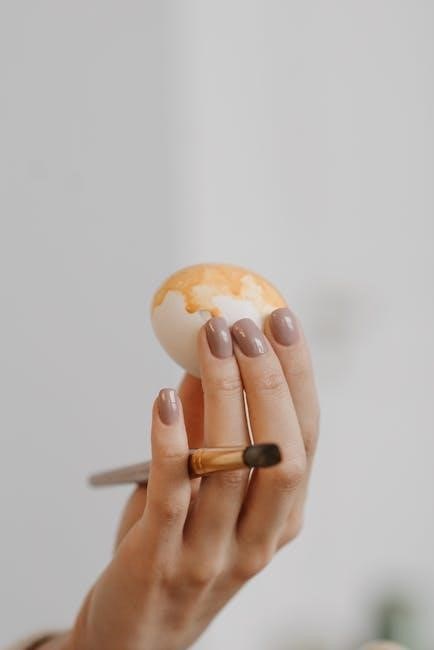
Always apply Motorcraft Lacquer Touch-Up Paint in a well-ventilated area to avoid inhaling harmful fumes․ Open windows or use fans to ensure good airflow․ Avoid working near open flames or sparks, as paint vapors are flammable․ Proper ventilation helps prevent dizziness and ensures the paint dries evenly․ If working indoors, consider using a portable ventilation system․ Never apply paint in enclosed spaces without adequate airflow, as this can lead to uneven curing and a poor finish․
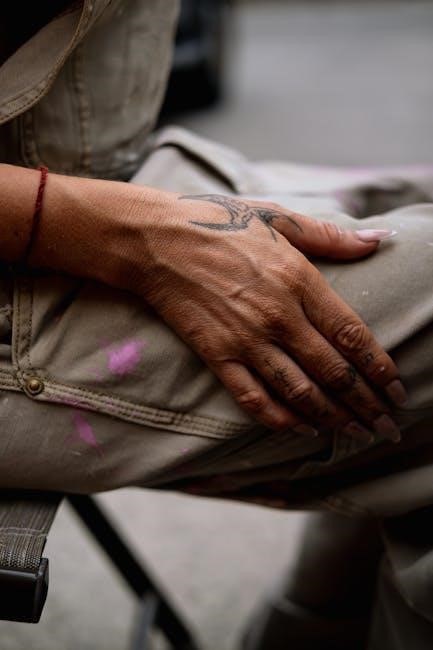
Additional Resources
Visit the Motorcraft website for detailed touch-up paint instructions and guides․ Explore recommended tools and accessories for achieving a professional finish, ensuring optimal results for your vehicle․
13․1 Where to Find Motorcraft Touch-Up Paint Instructions Online
Motorcraft touch-up paint instructions can be found on the official Ford Motorcraft website or through authorized Ford dealerships․ Additionally, detailed guides and video tutorials are available on YouTube and automotive forums․ Many users also share step-by-step instructions and tips for specific Ford models․ Ensure to search for your vehicle’s paint code and model year for accurate application guidance․ These resources provide comprehensive support for achieving a professional finish with Motorcraft Lacquer Touch-Up Paint․
13․2 Recommended Tools for a Professional Finish
For a professional finish, use high-quality brushes, fine-grit sandpaper (3000 grit), and a primer if needed․ A clear coat applicator ensures durability, while rubbing compound smooths the surface․ Microfiber cloths prevent lint residue, and a touch-up pen is ideal for small scratches․ Optional tools include spray cans for larger areas and a small artist brush for precise application․ These tools help achieve a seamless, factory-like finish when using Motorcraft Lacquer Touch-Up Paint․
